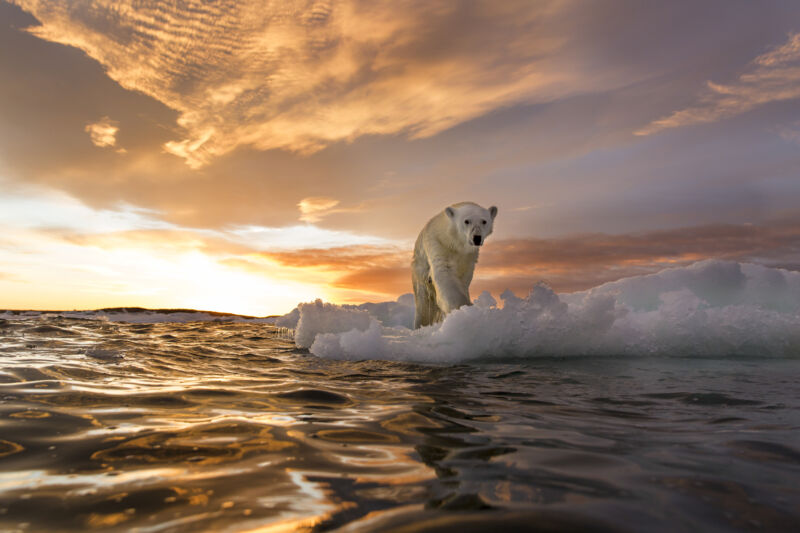

Unexpected polar bear population may offer some hope for the species
source link: https://arstechnica.com/science/2022/06/greenland-polar-bear-population-has-been-isolated-for-hundreds-of-years/
Go to the source link to view the article. You can view the picture content, updated content and better typesetting reading experience. If the link is broken, please click the button below to view the snapshot at that time.
Ice, ice, baby —
Unexpected polar bear population may offer some hope for the species
The remote place these bears call home could offer refuge as sea ice dwindles.
Doug Johnson - 6/21/2022, 11:00 AM

In the southeast corner of Greenland, scientists have discovered an unexpected population of polar bears. This population has developed distinct habits to survive in its odd—as far as polar bears are concerned—habitat, and the bears' genomes are quite different from many of their kin. Beyond the novelty these animals represent, they could also help inform scientists about how more traditional bears will fare in a warming Arctic, according to new research.
Several things set this group of bears apart. For much of the year, they survive by hunting from ice that falls into the ocean after breaking off a Greenland glacier; the ice floats in the fjords these bears call home. This is unlike most other populations of polar bears, which require sea ice for hunting. According to the World Wildlife Fund, between 22,000 and 31,000 polar bears are left in the world.
The research team used seven years of data collected in the region, along with 30 years of historic data. For the new data, the team connected with local hunters and used tissue samples taken from the hunters’ kills to sequence the bears' genomes. They also used fieldwork, satellite data—which also allowed them to study the geographical and sea ice conditions of the region—and tracking collars to get a sense of the bears’ movements.
“There’s a really large collection of data here,” Twila Moon, co-author of the paper and deputy lead scientist at the National Snow and Ice Data Center, told Ars. “It required a lot of time in the field. This is a very remote area that requires difficult, time-consuming, challenging conditions for field work.”
Estranged
The southeast of Greenland is quite poorly studied. This is because of its rough, mountainous terrain and unforgiving weather, which includes heavy snowfall. These difficulties also likely explain why the bears are isolated. The region is surrounded by mountains, by the Greenland Ice Sheet, and by the Denmark Straight.
Most polar bears make use of sea ice to hunt, but this is a limited option for the southeast Greenland bears. The region only sees sea ice between February and May. However, movement data suggests that the bears display some different behaviors from their kin. They likely walk on glacial ice that flows into the fjords and travel up the mountains to reach other fjords in search of food, often seals.
Advertisement“We were finding that sea ice rarely existed more than four months out of the year—in some fjords in some years, even much less than that,” Moon said.
According to the samples collected and sequenced, the bears are genetically quite different from others in the same species. There are 19 other observed polar bear populations, and their genomes are relatively similar to each other; this isolated sub-population stands out. According to the research, they are the most genetically isolated population of polar bears on Earth, and they may have been in this area of Greenland for hundreds of years.
A bear of an issue
As climate change continues to decrease sea ice levels, bears in other regions could adapt to live like the population in Greenland’s southeast. However, Moon suggested not getting too excited about this possibility. “There’s perhaps a tendency to want to feel that this is giving a [feeling of] ‘the polar bears are saved,’” she said. “Unfortunately, there are very [few] locations that provide lots of glacial ice in this way… For many Arctic polar bears, that kind of ice is not available.”
This means that many populations of polar bears won't have the opportunity to adjust to life on glacial ice as the southeast Greenland population has. The number of these Greenland bears is also quite small—just a few hundred individuals—possibly because of the difficulties the terrain poses when the bears try to find mates. As such, regions like the southeast of Greenland might not be able to sustain large groups of bears. Another issue: The Greenland Ice Sheet, which provides the glacial ice the bears use to hunt, is also melting. This is true for other glaciers around the Arctic, Moon said.
The bears in southeast Greenland do have a leg up in their difficult habitat, however. As the Greenland Ice Sheet loses ice, it does not retreat the same amount everywhere around the coast. Southeast Greenland gets a lot of snow in the winter, which helps feed the glaciers. The researchers also note that the region could act as a small-scale climate refugia, a place in which the species could survive for a time if sea ice continues to dwindle. The paper also notes that a few similar habitats exist in other parts of the Arctic, such as Svalbard—a Norwegian territory—and other parts of Greenland.
“That coastal ice we don’t expect to retreat away from its current location as quickly as areas of the Ice Sheet, for example, on the west or southwest coast,” Moon said. “It’s a nuanced environment.”
Science, 2022. DOI: 10.1126/science.abk2793 (About DOIs)
Recommend
About Joyk
Aggregate valuable and interesting links.
Joyk means Joy of geeK